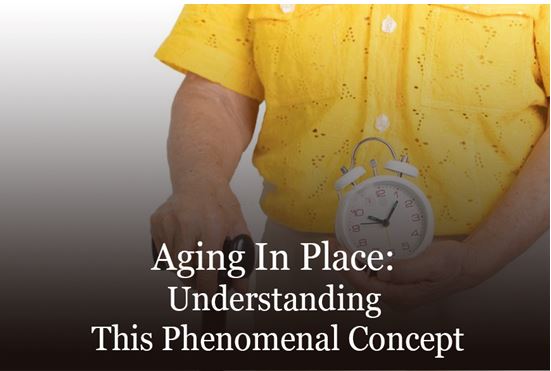The phrase aging in place refers to a person continuing to live in the home of their choice as they age, for as long as they can. This includes having access to any services or other assistance they may require when their demands evolve in the future.
To be clear, aging in place refers to a stage in an aged person’s life when they can still have access to the necessities of life while maintaining their standard of living.
This difference is essential because many individuals believe that aging in place would solve all of their difficulties. However, the only issues that can be resolved when aging in place are those that have been predictedearlier, like finances, health care, personal care, etc.
As I previously said, the goal of aging in place is to assist seniors in making sure they may remain where they choose to and receive whatever assistance they need for as long as they can. But it goes beyond that. Maintaining and/or enhancing one’s quality of life should be the focus of everyone who wants to age in place. Therefore, a comprehensive plan that prioritizes your quality of life and encompasses your house, money, care, and other aspects should be made as soon as possible in order to achieve that. This strategy should be maintained as your condition evolves to enable a consistent lifestyle.
According to an AARP poll of persons 65 and older, over 90% answered they would like to age in place. Most Americans either cannot afford continuing care or assisted living facilities or do not wish to spend their golden years in these facilities. Cultural traditions encourage some people to create family compounds to care for their elderly relatives, but for the majority, the only alternatives are to stay put as they age or move in with their offspring. The majority of the senior citizens I routinely spoke with while conducting research for my most recent book, Thursdays With Margaret (available online from Amazon and Barnes & Noble), were committed to creating plans that would enable them to continue living in their current homes.
These were long-retired middle-class and working-class people of moderate means who lived in a semi-rural region; they were probably typical of a sizable number of such areas across the nation. The majority of the group was eager to avoid doing so because they did not want to burden their children.
It might be challenging to plan ahead since you never know when your needs may change. Consider the kind of assistance you could require in the near future as a first step. It’s possible that you live alone and have nobody to turn to for assistance. Even if you don’t need assistance right now, you could share a home with a partner or relative who does. Everybody is in a different position.
Examining any medical conditions that you or your spouse may have, such as diabetes or emphysema, is one approach to start planning. Discuss with your doctor how these health issues may make it more difficult for a person to move around or take care of themselves in the future. For example, if you are an older adult’s caregiver, find out how you may help them obtain the assistance they require to remain in their own home.
Consumer Reports state that remodeling a home to allow for later-life aging in place can cost anywhere between $25,000 and $50,000 and that the average monthly cost of in-home care is $5,000, which is still likely less than the cost of a pricy continuing care retirement community. A few of the other possibilities for independent living—some of which equate to aging in place but in a different location—are included below.
Elderly Cohousing Communities (SCCs) are residential complexes featuring individual rooms or apartments and shared common areas that have been designed and/or purchased by a group of senior citizens. The purpose of SCCs, which are owned and run by the inhabitants, is to create and maintain a close-knit neighborhood of like-minded people. These communities may form on their own and are known as Naturally Occurring Retirement Communities (NORCs). Lists of these communities may be found by visiting The Cohousing Association of the United States.
55+ Retirement Communities are kinds of housing where only residents over a specific age are allowed to live. Residents may reside in a single-family house, a condo, or an apartment depending on the neighborhood. These target people who have similar interests, want to live in communities without kids and don’t yet need care.
Retirement communities with continuing care (CCRCs). This is an affluent style of a retirement house, as was previously said, and is typically fairly pricey. However, for those who can afford it, its benefits include a pleasant way of life with lots of facilities and the choice of in-house nursing and medical care.
There are also sizable senior communities like Latitude Margarita and The Villages in Florida and Sun City in Arizona for retirees of a particular mindset. They provide many of the same benefits, such as quick access to medical care, because they are on the verge of becoming tiny cities. Additionally, many are situated in warmer regions.
It isn’t easy to age in place in one’s own home and requires preparation and survival techniques. Therefore, people should be aware of the local services for the elderly that are offered by federal, state, and municipal organizations like human resource centers. The inability of these older people to use public transit to get to and from daily errands and doctor’s appointments is among the most pressing problems. Another problem is the excessive expense of in-home care, which neither Medicare nor Medicaid fully pay. As a result, seniors dealing with these two problems must establish their own resources by relying on friends, neighbors, and family in addition to using official institutional assistance.
There are numerous possibilities, but preparation is essential, especially for individuals with little resources who want to keep their independence and the problems that come with aging.




















































